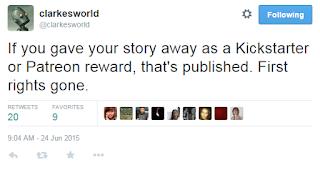So it’s finally happened – you’ve gotten the long awaited
acceptance letter. After a string of rejections, what a relief to see
confirmation that your work is ready to be read by the world! This is the big
moment when you get to celebrate seeing your name in print (and of course,
seeing your name in print on a paycheck as well).
If you’ve done your research, you should know already what
your contract is going to look like when it arrives from the publisher. But do
you really understand what all that jargon means? Now is not the time to just
sign your name in glee and skip over the fine print. Bad things still happen to
authors who aren’t careful, and inexperienced writers may discover too late
that they are not actually 100% on board with the terminology in their
contract. This is why it is very important to not only submit your work to
trusted markets, but to also do the research it takes to understand the end
product.
Let’s dive into the basic categories of rights that you will
see on most of your publishing contracts.
First Rights
First Rights in general are pretty much self-explanatory.
The journal or publishing house that is purchasing your work is purchasing the
right to distribute the story first.
The term First Rights is a large umbrella under which many other sub-categories
exist, but we’ll go through some of those later.
It is very important to understand that, even though First
Rights seem simple, many publishers are divided on what constitutes a work as
published or not. You can’t sell the exclusivity of something that has already
been let out of the bag, so be careful with what you do while you’re waiting to
sign a contract! Some publishers are very strict and will count any distribution
of the work as the loss of your First Rights. Once you’ve sold your First
Rights, the only other right you’re going to be selling is for reprints. This
severely narrows your ability to sell the story, since reprints are not the top
priority of many publishing houses.
A good rule of thumb is, when in doubt, hold on to your
work. Cater to the harshest critic and you will have no trouble selling to a
more lax editor. Neil Clarke (of Clarkesworld magazine) tested the waters on this
controversy via a twitter conversation recently, and you can see that some share his strict
point of view, while others would make exceptions. Later on he produced a
webpage narrowly defining some examples of what constitutes a work as published
or not. I highly recommend reading these rules before you make any attempts to
distribute your work on your own.
Subsidiary Rights
As mentioned before, First Rights is a very broad term that
covers a variety of subset rights. If you’re selling Exclusive or Unrestricted
First Rights, this means that you are selling the rights for all possible
subsets.
Rights can be determined based on language, geographic
location, type of distribution, etc. If you are seeking publication in an
American or Canadian literary journal, you are likely going to run across the
term “First North American Serial Rights.” This terminology is giving the
publisher the exclusive right to distribute the work to a North American
audience via a Serial publication (the magazine).
Some publishers will also request the rights to
audio/podcast versions of the work, or even sometimes video representation.
They may also throw in the right to publish the work in an anthology later on.
If you’re looking at all these restrictions and starting to
feel a little panicked, don’t worry. Remember, you ultimately own the copyright
of your work. You are simply selling certain features of it for a set amount of
time in very specified forms of media. Most publishers will only claim
exclusive rights of any type for a short period of time (for example, one
year). After that the rights become unexclusive and no longer have any bearing
on where you choose to reprint the work (unless this too was restricted in your
contract – so read the fine print!).
Also remember that once you sell even one subset of rights,
you can no longer sell your work to anyone who is looking for exclusive first
rights. So if a friend of yours wants to make an audio version of your story
for their weekly podcast, remember that will have an impact on whether or not
you can seek publication in print!
For a much more thorough breakdown of terminology that you
might come across, check out these awesome guides from The Internet Writing
Journal, Writing-World, and Poets&Writers:
Some other useful sources are Lightspeed Magazine’s Contract Template for Original Fiction, as well as author Nathan Bransford’s breakdown
of a basic publishing contract.
Questions? Let me know in the comments and I’ll be happy to
answer them for you. Happy submissions to you all!


No comments:
Post a Comment